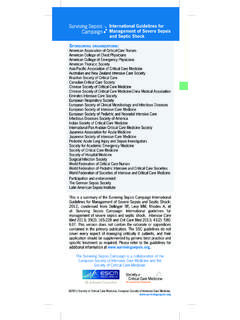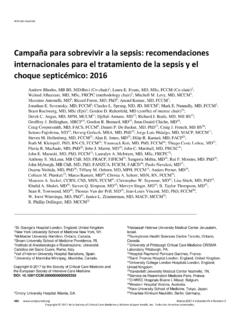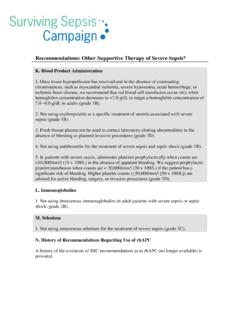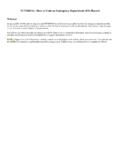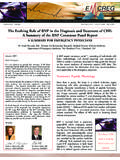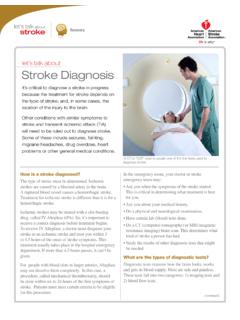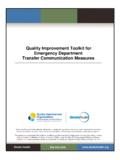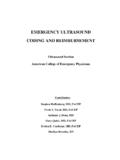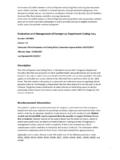Transcription of Statement from Surviving Sepsis Campaign …
1 Revised 5/2018 Statement from Surviving Sepsis Campaign Leadership on Time Zero Questions about the use of triage time in various care settings, particularly the emergency department (ED), as time zero for scoring compliance with the Surviving Sepsis Campaign (SSC) bundle have been raised since the bundle s 2005 introduction as a performance improvement tool. A 2018 revision of the SSC Sepsis bundle was recently completed; the rationale for this revision was published in both Critical Care Medicine and Intensive Care Medicine journals (see bundle tab at ).
2 Because the next phase of the performance improvement initiative will be based on the new hour 1 bundle, the SSC leadership continues to stress the importance of upholding standards for time zero. The 2018 change to the bundle has not materially altered the SSC s position on time zero. When time zero was defined, correspondence and discussion generated by the Infectious Disease Steering Committee of the National Quality Forum testimony were considered, as well as SSC Listserv comments. Currently, time zero or time of presentation is defined as the time of triage in the ED or, if presenting from another care setting, from the earliest chart annotation consistent with all elements of Sepsis (formerly severe Sepsis ) or septic shock ascertained through chart review.
3 Thoughtful consideration resulted in the following consensus points: 1. Time zero must offer the best balance of reliability and reproducibility while optimizing the value of the performance improvement program, leading to early diagnosis and appropriate treatment of Sepsis or septic shock. 2. The key to reducing mortality from Sepsis or septic shock is not just standardized evidence-based treatment but, equally important, the early recognition of Sepsis . 3. While some patients will not meet Sepsis criteria on ED arrival, altering time zero to chart documentation in the ED would: a.
4 Turn the bundle into a treatment-only bundle (rather than a diagnosis and treatment bundle) b. Diminish practitioners incentive to identify patients at risk based on history, symptoms, and examination findings in the ED or other points of presentation c. Reduce the reliability and reproducibility of time zero d. Make data collection more onerous and costly 4. Time zero based solely on physician diagnosis would miss the opportunity to clearly identify the time period leading up to diagnosis, a period that establishes the best target for performance improvement.
5 Without recognizing that the clock is ticking, there is no incentive to recognize a challenging diagnosis early. Revised 5/2018 Despite best intentions, patient care may be compromised when identification of Sepsis is delayed. SSC leadership remains sympathetic to those who point to the potential scenario of a patient whose only criteria for the diagnosis of Sepsis is hypotension, with previous normotensive blood pressure recordings. However, the alternative of adjusting time zero for this particular occurrence in the bundle timeline would add a level of complexity to data entry and analysis judged to be counterproductive to the performance improvement program.
6 For example, the alternative of making time zero the onset of hypotension (if it occurs later in the ED stay) would falsely penalize sites for initiating treatment before the onset of hypotension and/or decrease the number of observed cases meeting Sepsis criteria. If a site opts to use onset of hypotension as time zero, compliance with lactate, blood culture, antibiotics, and probably fluid administration will occur outside of the time window because they were probably performed before the time of presentation.
7 This suggested alternative method of tracking performance may increase the time window to resuscitation end points but cannot ensure that a timely response to resuscitation measurement will be made. The importance of close monitoring in Sepsis patients cannot be underestimated. Later development of hypotension in patients who were normotensive at triage is not the only indication of Sepsis . Awareness of other organ dysfunction is equally important. Frequent observations for changes in vital signs will lead to early recognition and improved outcomes.
8 Despite a clinician s occasional inability to achieve the time-sensitive indicators due to late onset of symptoms or long elapsed time in the ED or other care settings, patients say that early detection and treatment of their health problem is preferable. The conclusions and recommendations for the next phase of SSC are to: For presentation in the ED, continue to use triage time as time zero For non-ED presentation, continue to use as time zero the earliest chart annotation consistent with all elements of Sepsis (formerly severe Sepsis )
9 Or septic shock as ascertained through chart review Maximize the bundle s effectiveness for diagnosis as well as treatment Acknowledge that some patients may not meet criteria for Sepsis at triage Recognize that 100% compliance for some indicators is not always possible, but that whatever compliance can be achieved is likely converted to percentiles of performance by regulatory agencies, as is done for other compliance metrics. P90 performance, while a lower level of compliance, is still in the top decile.
10 References 1. Dellinger RP, Schorr CA, Levy MM. A users guide to the 2016 Surviving Sepsis Guidelines. Crit Care Med. 2017 Mar;45(3):381-385. 2. Rhodes A, Evans LE, Alhazzani W, Surviving Sepsis Campaign : international guidelines for management of Sepsis and septic shock: 2016. Crit Care Med. 2017 Mar;45(3):486-552.

